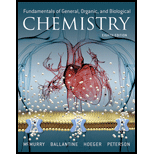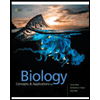
Fundamentals of General, Organic, and Biological Chemistry (8th Edition)
8th Edition
ISBN: 9780134015187
Author: John E. McMurry, David S. Ballantine, Carl A. Hoeger, Virginia E. Peterson
Publisher: PEARSON
expand_more
expand_more
format_list_bulleted
Concept explainers
Question
Chapter 29, Problem 29.19AP
Interpretation Introduction
Interpretation:
The body part where the lymph enters the blood stream has to be given.
Concept Introduction:
Lymphatic system:
- Composed of lymph vessels, lymph nodes, lymphocytes, spleen and thymus gland.
- It protects body from disease and infection.
- It transports a watery fluid, lymph from tissues to the veins.
- Lymph is the fluid which gives immune cells and other required factors throughout the body.
- It transports fat from intestinal lymph vessels to cardiovascular system.
- Majority of the lymph fluid enters the blood stream through thoracic ducts.
Expert Solution & Answer
Want to see the full answer?
Check out a sample textbook solution
Students have asked these similar questions
walk me through how you would answer this please
please help and show arrow pushing.
please work through it and explain how you got the answers
roblem Two – part aFirst separation step.....What type of column was used? __________________________ pH used: ________Protein(s) in early fraction? ____________ protein(s) in late fraction? _______Second separation step....Proteins applied to the second column? ___________What type of column was used? __________________________ pH used: ________Protein(s) in early fraction? ____________ protein(s) in late fraction? _______
Chapter 29 Solutions
Fundamentals of General, Organic, and Biological Chemistry (8th Edition)
Ch. 29.1 - Prob. 29.1KCPCh. 29.3 - Prob. 29.1CIAPCh. 29.3 - Prob. 29.2CIAPCh. 29.3 - Prob. 29.3CIAPCh. 29.3 - Prob. 29.4CIAPCh. 29.3 - Match each term in the (a)(e) group with its...Ch. 29.5 - Prob. 29.3KCPCh. 29.5 - Prob. 29.4PCh. 29.5 - Prob. 29.5PCh. 29.8 - Prob. 29.5CIAP
Ch. 29.8 - Prob. 29.6CIAPCh. 29.8 - One of the more advanced blood tests used to...Ch. 29 - Body fluids occupy two different compartments,...Ch. 29 - Prob. 29.7UKCCh. 29 - Prob. 29.8UKCCh. 29 - Prob. 29.9UKCCh. 29 - Prob. 29.10UKCCh. 29 - Prob. 29.11UKCCh. 29 - Prob. 29.12UKCCh. 29 - Prob. 29.13APCh. 29 - Prob. 29.14APCh. 29 - Prob. 29.15APCh. 29 - Prob. 29.16APCh. 29 - Prob. 29.17APCh. 29 - Prob. 29.18APCh. 29 - Prob. 29.19APCh. 29 - Prob. 29.20APCh. 29 - Prob. 29.21APCh. 29 - Prob. 29.22APCh. 29 - Prob. 29.23APCh. 29 - What are the three main types of cells found in...Ch. 29 - Prob. 29.25APCh. 29 - Prob. 29.26APCh. 29 - Prob. 29.27APCh. 29 - Prob. 29.28APCh. 29 - Prob. 29.29APCh. 29 - Prob. 29.30APCh. 29 - Prob. 29.31APCh. 29 - Prob. 29.32APCh. 29 - Prob. 29.33APCh. 29 - Prob. 29.34APCh. 29 - Prob. 29.35APCh. 29 - Prob. 29.36APCh. 29 - Prob. 29.37APCh. 29 - Prob. 29.38APCh. 29 - Prob. 29.39APCh. 29 - Prob. 29.40APCh. 29 - Prob. 29.41APCh. 29 - Prob. 29.42APCh. 29 - What color is deoxyhemoglobin? Why?Ch. 29 - Prob. 29.44APCh. 29 - Prob. 29.45APCh. 29 - Prob. 29.46APCh. 29 - Prob. 29.47APCh. 29 - Prob. 29.48APCh. 29 - Prob. 29.49APCh. 29 - Prob. 29.50APCh. 29 - Prob. 29.51APCh. 29 - Prob. 29.52APCh. 29 - Prob. 29.53APCh. 29 - Prob. 29.54APCh. 29 - Prob. 29.55CPCh. 29 - Prob. 29.56CPCh. 29 - Prob. 29.57CPCh. 29 - How does active transport differ from osmosis?Ch. 29 - Prob. 29.59CPCh. 29 - Prob. 29.60CPCh. 29 - Prob. 29.61CPCh. 29 - Prob. 29.62CPCh. 29 - Have each member of your group choose an energy...Ch. 29 - Prob. 29.64GPCh. 29 - Prob. 29.65GP
Knowledge Booster
Learn more about
Need a deep-dive on the concept behind this application? Look no further. Learn more about this topic, biochemistry and related others by exploring similar questions and additional content below.Similar questions
- please help and explair you'd count the disulfide bonds caused by the cystines and include the n and c terminusarrow_forwardc. C₂H₂ 'alkyne d. C7H12 alkyne 2. Draw the line-angle formula for the following compounds. a. 4,4-diethyloctane 2 3 7 8 b. 4-ethyl-2,2-dimethylhexanearrow_forwardHenderson Hasselbalch Practice Sheet. 1) Buffered solution 1 has a pH of 8. [A-] = 100 mM, [HA] = 10 mM. Solve for pKa of this acid. 2) A phosphate buffer (pk2 = 7.2) has molar concentrations of [H2PO4 ] = 100 µM, [HPO42-] = 1 mM. Solve for pH. = 3) When pH 5, the pKa of the acid = 7, and the molar concentration of acid = 100 μM, what is the molar concentration of the base? 3arrow_forward
- 7. Which one is the major organic product obtained from the following reaction? CHO COOH CH₂OH CHO COOH H- -OH H₂ H- OH H- -OH H- -OH Ni HO -H HO -H HO- -H HO- H HO- H H- -OH H- -OH H- -OH H -OH H- -OH H- -OH H- -OH H- -OH H- -OH H -OH CH₂OH CH₂OH CH₂OH CH₂OH COOH A B C Darrow_forward4. The compound on the right is- B) a ketopentose C) an aldohexose A) an aldopentose D) a ketohexose E) a ketoheptose OH OH CH2OH OHarrow_forward12. When glutamic acid is heated to 180°C., it loses a molecule of water to form a lactam. The bond that creates the lactam is an amide bond that forms between the amino nitrogen and the carbon of the side chain -COOH group. What is the most reasonable structure for this lactam? (NOTE: The structure of glutamic acid is shown in Question 1.) COOH COOH ا کچھ جو کچھ C D COOH B COOH E COOHarrow_forward
- 10. Which one of the following compounds is the major organic product of the series of reactions shown here? Ph A OH Ph B CO₂Et Br -H Ν ΚΑ CO₂Et 1. NaOEt 1. NaOH, H₂O 2. H3O+ 2. PhCH2CH2Br 3. heat NH2 Ph OH NH2 0 OH Ph OH NH2 Ph D NH2 E OHarrow_forward1. What is the isoelectric point of glutamic acid? (Glutamic acid has pKa1 2.10, pKa2 4.07, pKaз 9.47) A) pH 2.1 D) pH 6.8 B) pH 3.1 C) pH 4.1 E) pH 9.5 HO NH2 Glutamic acid (shown without charges) OHarrow_forwardBr Mg, ether 1. HCHO (formaldehyde) 2. H+, H₂O PCC 1. NH3, HCN ? (pyridinium chlorochromate) 2. H2O, HCI 11. Which one of the following compounds is the major organic product of the series of reactions shown above? Ph. Ph. OH NH2₂ A Ph. Ή NH2 B OH Ph Η Ph OH NH2 NH2₂ NH₂ C D Earrow_forward
- B A 6. Which ONE of the labeled bonds in the tripeptide on the right is a peptide bond: H₂N N 'N' OH C H A, B, C, D or E? HN E OHarrow_forwardQuestions 8-9 are 0.4 points each. The next two questions relate to the peptide whose structure is shown here. To answer these questions, you should look at a table of H2N/.. amino acid structures. You don't have to memorize the structures of the amino acids. IZ 8. What is the N-terminal amino acid of this peptide? A) proline B) aspartic acid C) threonine 9. What is the C-terminal amino acid of this peptide? A) proline B) aspartic acid C) threonine N OH D) valine E) leucine D) valine E) leucine NH "OH OHarrow_forward7. What is the correct name of the following tripeptide? A) Ile-Met-Ser B) Leu-Cys-Thr C) Val-Cys-Ser D) Ser-Cys-Leu E) Leu-Cys-Ser H₂N!!!!! N H ΖΙ .SH SF H IN OH OHarrow_forward
arrow_back_ios
SEE MORE QUESTIONS
arrow_forward_ios
Recommended textbooks for you
 Biology (MindTap Course List)BiologyISBN:9781337392938Author:Eldra Solomon, Charles Martin, Diana W. Martin, Linda R. BergPublisher:Cengage Learning
Biology (MindTap Course List)BiologyISBN:9781337392938Author:Eldra Solomon, Charles Martin, Diana W. Martin, Linda R. BergPublisher:Cengage Learning

Biology (MindTap Course List)
Biology
ISBN:9781337392938
Author:Eldra Solomon, Charles Martin, Diana W. Martin, Linda R. Berg
Publisher:Cengage Learning




